Compensating for the Rising: the papers of the Property Losses (Ireland) Committee, 1916
Published in 20th-century / Contemporary History, Features, General, Issue 2 (March/April 2013), Revolutionary Period 1912-23, Volume 21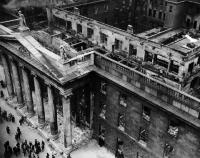
A view of the ruins of the GPO from Nelson’s Pillar and along Henry Street—the houses from the Pillar to Moore Street had been completely levelled, with nothing but piles of broken brick, twisted iron and charred wood left in their place. (National Museum of Ireland)
Several hundred uncatalogued claims made by householders and business-owners between May and August 1916 have recently been discovered in the National Archives. Typically, each claim is organised into a pro-forma and a schedule of losses, followed by correspondence between insurers, solicitors and other parties. In some instances architectural drawings or contractors’ receipts are included. For obvious reasons, those that relate to businesses in the commercial district adjoining the GPO are of significant interest. They not only provide crucial details about how ordinary traders fared at the epicentre of the fighting but also give important clues about how siege barricades were set up and which buildings were occupied by British troops.
Moore Street market closed
Some of the claims show how quickly chaos descended on the Moore Street area. Within hours of the rebels taking the GPO, for instance, Gorman’s shop at No. 15 was denuded of its ‘2,000 Woodbine cigarettes, 500 Players, 300 Gold Flake and 700 Park Drive’, whereas Cogan’s at Nos 10–12 lost its entire stock-in-trade, to the value of £780. At Nos 11, 23 and 23 Moore Street, looters spirited away tins of biscuits, Skipper sardines, John West salmon and fruit, as well as Oxo cubes, packets of butter, pickles and jam. And they did not forget to take the cutlery to eat it with.This situation was made worse by the closure of the police station on Henry Street. When three policemen were shot on the first day of the fighting, the commissioner took his men off the streets, but although taken initially by surprise, the authorities soon rallied, and concerted efforts were made to bring in British troops. Arriving on Parnell Street, the soldiers scouted for vantage points from which to lay siege to the GPO. Here again the compensation papers tell us something about how this unfolded. At first the British army could not be sure of all the rebel positions, but within a short space of time troops had occupied a number of buildings, including the Marine Stores at No. 18 Little Denmark Street and the Typographical Society—an imposing four-storey building whose top windows afforded an excellent view of the Henry Street/Liffey Street junction. Once the soldiers had taken up their positions, the GPO rebels were unable to engage in a great deal of direct fighting.
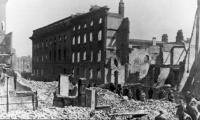
along Henry Street
As the week dragged on, local people began to starve in their houses. The fruit and vegetable market at Halston Street remained closed for ten days. One trader lost three barrels of apples, 10? cases of lemons and 90 bunches of bananas to over-ripening. Looters also managed to get into sheds belonging to Ted Castle McCormick at Sir John Rogerson’s Quay, where they carted away a staggering 28 bags of Egyptian onions. With Moore Street market closed, Dubliners bicycled into the rural hinterland of the city to buy milk, butter, meat and eggs from small farmers. In other places, the army broke open stores and warehouses in order to feed civilians.By the middle of the week, British soldiers had assembled a barricade at the Parnell Street end of Moore Street. It was made from butchers’ blocks, crates and barrels, as well as a pony van that was turned on its side. This belonged to a Mrs Kelly from Nos 24 and 25 Moore Street. The final surrender came on Saturday 29 April. Patrick Pearse saw three civilians shot dead as they carried white flags in the street outside. On that basis he decided that it was time to call a halt to the fight.
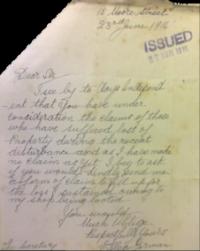
On 23 June, Ellen Gorman of No. 15 Moore Street read the newspaper advertisement of the Dublin Fire and Property Losses Association for the first time and wrote to the secretary:
‘Dear Sir,
I see by today’s Independent that you have under consideration the claims of those who have suffered loss of property during the recent disturbance and as I have made no claim as yet, I beg to ask if you would kindly send me a form of claim to fill up for the loss I sustained owing to my shop being looted.
You would much oblige.
Respectfully yours,
Ellen Gorman’
(NAI)
Utter devastation
The barricades remained on the street for several weeks after the Rising. In an attempt to curb further looting and to deter sightseers, a wooden fence and a night-watchman’s box were installed at the GPO end of Henry Street. Beyond this, the scene was one of utter devastation. Looking along the right-hand side of Henry Street from Nelson’s Pillar, the houses had been completely levelled as far as Moore Street, with nothing but piles of broken brick, twisted iron and charred wood left in their place. The buildings flanking the entrance to Cole’s Lane had all but disappeared. The shelves at Samuel’s Bazaar, Norton’s and Lyons’ on Henry Street had been emptied by looters, but Arnott’s was still intact. Witnesses described seeing costly pianos being rolled down the street, along with suites of furniture, boots, hats and other items of clothing. The police later recovered some of these articles tucked away in basements or in attics across the city.
A worrying time lay ahead for local traders. In an effort to restore some semblance of normality, the owners of licensed premises were prohibited from opening. Many of the other shops were back in business by 3 May, but some were forced to take up temporary premises in other parts of the city. Having moved to Grafton Street, one firm displayed a burnt piece of shop fitting outside. ‘Our Henry Street branch has been transferred to this address’, it read. ‘Here it is. The only relic left.’ Such relocation was expensive, however. Business-owners were still liable to pay ground rent on their damaged sites, but in effect this meant paying twice—once for the temporary premises and again for the old site.
Dublin Fire and Property Losses Association
In an effort to address these and other issues, the Dublin Fire and Property Losses Association was formed on Monday 8 May under the leadership of businessman William Martin Murphy. Its committee invited local property-owners to submit claims for damaged property, with the government agreeing to indemnify the losses. Such governance proved essential. Some insurers, such as Commercial Union, were already trying to use a force majeure clause to avoid paying out for plate glass damaged by ‘war or invasion’.
In total, almost 60 claims were lodged by market traders. Over half came from Moore Street, with the remainder pertaining to buildings in the adjoining streets. Soon almost all of the city’s available builders were employed in clearing away the debris—an unexpected boon, considering the depressed state of the construction industry.
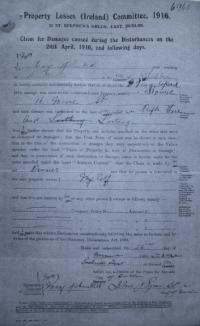
The compensation form filled in by Mary Plunkett, 16 Moore Street (last headquarters of the rebels), in November 1916—deemed ineligible because she missed the 18 August deadline. (NAI)
The market is rebuilt
Some local property-owners had come through Easter Week relatively unscathed. Others, such as Samuel Corbett of Nos 14 and 15 Horseman’s Row, had more significant issues to contend with. Contractors’ invoices listed damage to his roofs and walls, hall doors and shop shutters. No. 23 Cole’s Lane, which belonged to clothes-dealer Joseph Durkin, required thirteen new frames of glass, two shutters, a door lock and a rainwater pipe—a result of ‘firing of cannon immediately outside premises, by rifle fire and by bayonet’.
None of the sites were fenced over with hoarding. This caused at least one business-owner (a milliner from 16 Mary Street) to write a letter of complaint to the chief commissioner of the Dublin Metropolitan Police. He claimed that he had been injured by stones thrown by gangs of youths who continued to gather, ‘though the proclamation says they should not do so’. A further gripe was that they tended to put ‘their dirty backs against door fronts newly-painted’.As life returned to the area, some businesses were obliged to reopen under new management owing to the death of the previous owner during the Rising. One such was the spirit grocer’s at No. 57 Moore Street. Others reopened in temporary structures. These were little more than one-storey shacks but, with their timber uprights and external cladding of galvanised iron or cement plaster, they served a purpose until more permanent work could be done. Two businesses that reopened temporarily like this were McDowell’s Jeweller’s at No. 27 and Messrs Marks & Co., who ran a ‘Penny Bazaar’ at No. 37. The following description of Marks appeared in the Irish Builder:
‘The structure will be roofed in by timber trusses, covered externally with asphalt. The floors of the shop, stores and rear are to be carried on timber posts from the basement level. The front of the bazaar will be enclosed by folding doors on either side with moveable shutters in the centre. A heavy fascia board is to be put on which will help to mask the ugly outline of the rake of the roof. Light and ventilation will be obtained from the roof.’
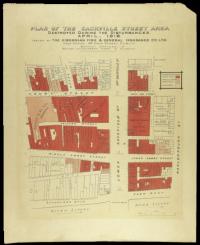
Map of the GPO and surrounding area issued by the Hibernian Fire and General Insurance Co. Ltd, indicating buildings destroyed or damaged by fire. Some insurers tried to use a force majeure clause to avoid paying out for plate glass damaged by ‘war or invasion’.
In other parts of the market, traders were keen to rebuild straight away. By early July the debris had been removed from Nos 1 and 2 Moore Street, trenches opened and foundations put in.
Contractors’ invoices were carefully retained until the Fire and Property Losses Association had a chance to see them. In most cases compensation was fair, albeit falling slightly short of what the owner had listed on the claim form. In the case of Thomas Cogan, whose shops at Nos 10 and 12 Moore Street had been looted, no allowance was made for a £7 sewing machine. Similarly, an invoice submitted by Elias Eliassoff of 18 Little Denmark Street was struck out on the basis that ‘the damage is so trivial in the front portion that the claimant has been able himself to repair it’. In November 1916 Mary Plunkett, whose shop at No. 16 Moore Street became the last headquarters of the rebels, tried to claim for an outside electric lamp, a child’s cot, a drawing-room table and four linen sheets, but her submission was deemed ineligible on the basis that she had not met the 18 August deadline.
Lesson learned
‘If anything like modern fire resisting construction had existed, even here and there, the fire might have been stayed and limited to sections; had the steel work been protected by concrete casing, many walls would today be standing and whole sections might possibly have been cut off from the fire.’
![The case of Francis Fee of No. 59 Moore Street was particularly difficult. Shortly after the Rising, he had a temporary roof put on his fire-damaged building. The roof cost £40, but the association refused to pay, leaving him out of pocket. Fee’s architect wrote on 4 August:‘In the interest of my client, I think it is only fair I should point out that the plans which I lodged with you have not been submitted to, or approved of by the city authorities . . . [D]irectly after the rebellion, they notified Mr Fee that his premises were in a dangerous condition [and] may insist on more of the superstructure being taken down, and so put us to further expense, in which case Mr Fee’s claim will have to be increased by the value of such requirements of the city authorities.’ Along the street, several chimney-stacks had toppled over and the cobbles were littered with slates, shaken loose by the constant vibration of heavy machine-gun fire. This exposed interior walls to rain damage and added to the rebuilding costs. (NAI)](/wp-content/uploads/2013/03/Compensating-for-the-Rising-6.jpg)
The case of Francis Fee of No. 59 Moore Street was particularly difficult. Shortly after the Rising, he had a temporary roof put on his fire-damaged building. The roof cost £40, but the association refused to pay, leaving him out of pocket. Fee’s architect wrote on 4 August:
‘In the interest of my client, I think it is only fair I should point out that the plans which I lodged with you have not been submitted to, or approved of by the city authorities . . . [D]irectly after the rebellion, they notified Mr Fee that his premises were in a dangerous condition [and] may insist on more of the superstructure being taken down, and so put us to further expense, in which case Mr Fee’s claim will have to be increased by the value of such requirements of the city authorities.’
Along the street, several chimney-stacks had toppled over and the cobbles were littered with slates, shaken loose by the constant vibration of heavy machine-gun fire. This exposed interior walls to rain damage and added to the rebuilding costs. (NAIn had existed, even here and there, the fire might have been stayed and limited to sections; had the steel work been protected by concrete casing, many walls would today be standing and whole sections might possibly have been cut off from the fire.’
Further reading
S. Ferguson, GPO staff during the 1916 Rising (Cork, 2012).
F. McGarry, The Rising: Ireland, Easter 1916 (Oxford, 2010).
















